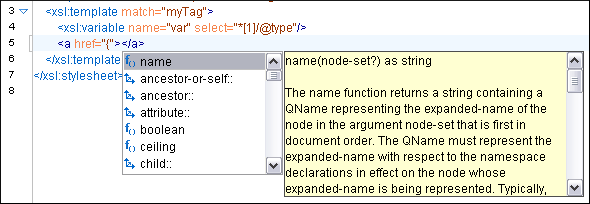Content Completion in XPath Expressions
In XSLT stylesheets, the Content
Completion Assistant provides all the features available in the XML
editor and also adds some enhancements. In XPath expressions used in attributes of
XSLT stylesheets (such as @match, @select, and
@test), the Content Completion Assistant offers the names of
XPath and XSLT functions, XSLT axes, and user-defined functions (the name of the function and
its parameters). If a transformation scenario was defined and associated to the edited
stylesheet, the Content Completion Assistant computes and presents elements and
attributes based on:
- The input XML document selected in the scenario.
- The current context in the stylesheet.
The associated document is displayed in the XSLT/XQuery Input view.
Content completion for XPath expressions is started:
- On XPath operators detected in one of the
@match,@select, and@testattributes of XSLT elements:",',/,//,(,[,|,:,::,$ - For attribute value templates of non-XSLT elements, that is the
{character when detected as the first character of the attribute value. - On request, if the combination Ctrl + Space is pressed inside an edited XPath expression.
The proposals presented in the Content Completion Assistant are dependent on:
- The context of the current XSLT element.
- The XML document associated with the edited stylesheet in the stylesheet transformation scenario.
- The XSLT version of the stylesheet (1.0, 2.0, or 3.0).Note: The XSLT 3.0 content completion list of proposals includes specific elements and attributes for the 3.0 version.
For example, if the document associated with the edited stylesheet is:
<personnel>
<person id="Big.Boss">
<name>
<family>Boss</family>
<given>Big</given>
</name>
<email>chief@oxygenxml.com</email>
<link subordinates="one.worker"/>
</person>
<person id="one.worker">
<name>
<family>Worker</family>
<given>One</given>
</name>
<email>one@oxygenxml.com</email>
<link manager="Big.Boss"/>
</person>
</personnel>
If you enter an <xsl:template> element using the Content
Completion Assistant, the following actions are triggered:
- The
@matchattribute is inserted automatically. - The cursor is placed between the quotes.
- The XPath Content Completion Assistant automatically displays a pop-up window with all the XSLT axes, XPath functions and elements and attributes from the XML input document that can be inserted in the current context.
The set of XPath functions depends on the XSLT version declared in the root element
xsl:stylesheet: 1.0, 2.0, or 3.0. Functions from other namespaces, such as
maps, arrays, and math, are presented only if the namespaces are
declared.
@match Attribute
If the cursor is inside the @select attribute of an
<xsl:for-each>, <xsl:apply-templates>,
<xsl:value-of> or <xsl:copy-of> element the
content completion proposals depend on the path obtained by concatenating the XPath
expressions of the parent XSLT elements <xsl:template> and
<xsl:for-each> as shown in the following figure:
@select Attribute
Also XPath expressions typed in the @test attribute of an
<xsl:if> or <xsl:when> element benefit of the
assistance of the content completion.
@test Attribute
XSLT variable references are easier to insert in XPath expressions with the help of the
content completion pop-up triggered by the $ character, which signals the
start of such a reference in an XPath expression.
@test Attribute
If the { character is the first one in the value of the attribute, the same
Content Completion Assistant is available also in attribute value templates of
non-XSLT elements.

The time delay (configured in the Content Completion preferences page) is also applied for the content completion in XPath expressions.
